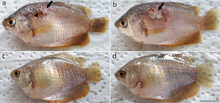Iridovirus dwarf gourami disease
| Iridovirus dwarf gourami disease | |
|---|---|
 | |
| Dwarf gouramis infected with another disease displaying ulcers, a common symptom of DGD | |
| Specialty | Aquarium disease |
| Symptoms | Loss of colour, loss of appetite and deterioration of muscle.[1] |
| Complications | Necrosis of the kidney and spleen |
| Usual onset | 1 day-6 months post exposure |
| Causes | Megalocytivirus likened by inbreeding |
| Risk factors | Highly infectious amongst Gourami |
| Diagnostic method | Observation of symptoms |
| Prevention | Obtaining Dwarf gourami from reputable sources, keeping them in a low-stress environment. Once infected, avoid adding any gourami to the aquarium for a period of three months |
| Treatment | None, always fatal |
| Medication | None |
Iridovirus dwarf gourami disease is a widespread consequence caused by the poor genetics of the dwarf gourami, a popular fish in the aquarium trade. It is the result of severe inbreeding.[2] Despite being unable to develop the disease, other gourami become prone to infection if a dwarf gourami in the tank gets the Iridovirus. Once symptoms develop, the gourami's mortality rate reaches 100% and there is no cure nor treatment.
References
- ^ "DGD". helpusfish. April 2020. Retrieved 14 January 2022.
- ^ "DG inbreeding". tankaddict. Retrieved 14 January 2022.
